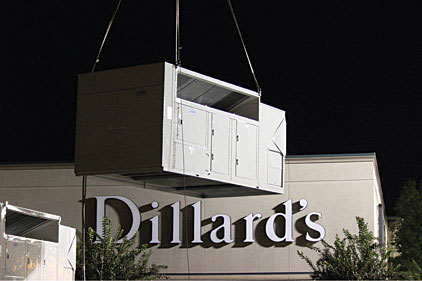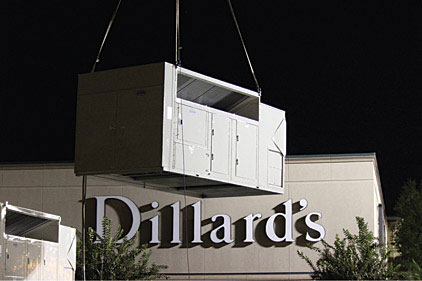
|
| A new rooftop unit at a Florida department store upgraded compressors and supply fan VFD’s to increase its part-load flexibility. |
When the Dillard’s department store in Naples, FL, reached the point where its rooftop HVAC equipment was in need of replacement, company officials decided to put energy savings as the primary goal. The goal was to save 20% operating costs over the five years after installation, with an expected unit life of 25 years at the 180,000-sq-ft facility. Because this was a Gulf Coast application, they also needed a solution that could accomplish the energy savings while offering corrosion protection to extend the unit life.
Tom Goetz, senior corporate director of technical operations and engineering, summed up the need by saying, “The primary reason for these units was to achieve a comfortable shopping environment with the lowest energy cost.”
Dillard’s had experience with AAON rooftop equipment using it on the majority of its department stores, but the equipment employed conventional HVAC technology such as on/off compressors and two-speed supply fans. Engineers believed this was the chance to break the mold and aggressively pursue the energy savings goal. The choice was to use 10 40-ton RN Series rooftop units to condition the retail space and one 15-ton RN Series rooftop unit to condition the office space.
Part-Load Efficiency
Dillard’s had ample experience working with on/off compressors, but knew they could not use them if they wanted to capture additional energy savings. Why? Standard on/off compressors operate at 100% capacity when there is any demand for cooling. During low-load conditions, in order to avoid evaporator frosting, hot gas bypass may be required. With controls in place to ensure minimum compressor operating times, this can lead to the system consuming 100% of the energy to provide only a partial amount of the cooling, the equivalent of trading one dollar for fifty cents or less. This can result in a significant amount of energy waste, and the system cannot precisely control the conditioned space temperature.
Working with Jim Peed, the AAON sales representative with Preferred Equipment Co., Dillard’s decided the solution was to use the 10% to 100% variable capacity scroll compressors and take advantage of the part load efficiency.
“Specifying variable capacity compressors on AAON equipment will save building energy costs,” said Peed.
Each of the RN Series rooftop units used variable capacity compressors on the lead refrigeration circuit. By doing this, Dillard’s was able to maximize the part load efficiency by precisely matching the conditioned space load and tightly control the supply air temperature. A benefit of the variable capacity compressors is that they can quickly change capacity within 15-second intervals as the demand requires it. This load matching capability resulted in dollar savings and put Dillard’s in position to reach its goal.
Supply Fan Savings
While the variable capacity compressors moved them closer to their energy savings goal, Dillard’s needed more. According to officials, including VFDs on the supply fans was the perfect solution. Much like the variable capacity compressors, supply fan VFDs fully modulate fan speed in accordance with demand.
The store had the variable capacity compressors modulate to maintain a constant supply air temperature and the supply fans speed up or slow down to maintain the space temperature setpoint of the conditioned space. This was done through a Dillard’s developed control algorithm. This control algorithm contributed to Dillard’s achieving its goal of energy savings.
By cutting fan speed in half, the required fan power reduces by a factor of eight leading to significant dollar savings. This allows the supply fan motor to run at a more efficient duty point and increases energy savings. The recent improvements in VFD technology make this fan speed control far more reliable and readily available for all sizes of motors.
Coastal Corrosion Protection
The next step was corrosion protection of the rooftop equipment. Along with the high concentrations of airborne salinity, there is year round high relative humidity that can cause exposed metal surfaces to corrode at an extremely fast rate.
To alleviate coil corrosion concerns, Dillard’s chose to use polymer e-coated condenser coils on their RN Series rooftop units. The 6,000-hr salt spray tested complete coil coating that protects the aluminum fin, copper tube condenser coils from the atmospheric corrosion that would normally shorten the lifespan of the coils. The standard paint that AAON began using in 1996 provides the RN Series unit cabinet with corrosion protection. The 2,500-hour salt spray tested paint covers all panels and fasteners and leaves no exposed exterior metal surfaces, rendering the corrosive atmosphere powerless.
In the end, Dillard’s was able to target energy savings and deal with environmental difficulties. The proposed 20% savings with the Naples store was a lofty goal, but five months after installation with a full peak cooling season behind them, Dillard’s saw over a 23% decrease in electricity expense and a 20% reduction in kWh/sq ft. They also saw over a 22% drop in peak kW demand because of the functionality of the variable capacity compressors and VFD controlled supply fans.




